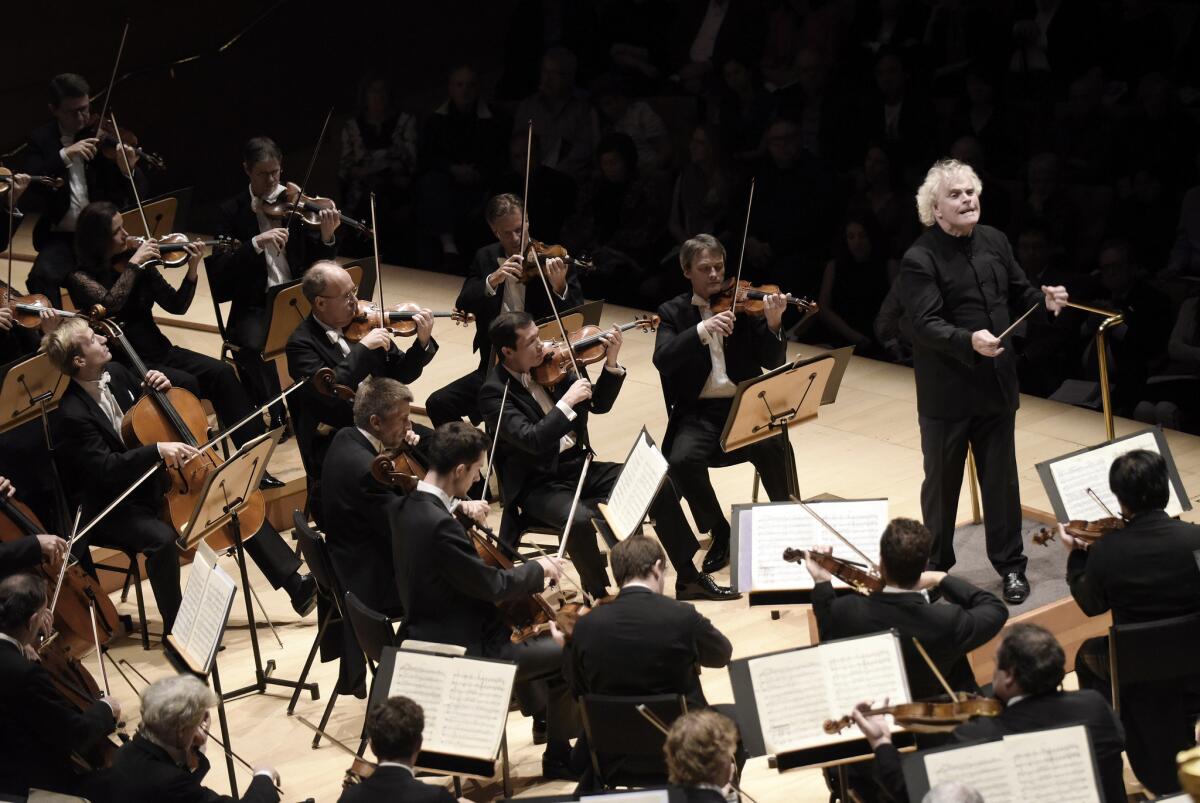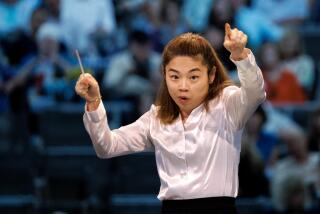Review: Is Berlin the worldâs best orchestra? Answer is irrelevant in two concerts of ferocity and finesse

It isnât easy being the greatest orchestra in the world. Whether or not the Berlin Philharmonic really is that is not the issue so much as the expectation that it be the best.
The arguments are endless about the orchestraâs sound, refinement, depth and so on. For my part, I would have been made distinctly uncomfortable by playing any better than what I heard from the Berlin Philharmonic in programs at Walt Disney Concert Hall on Saturday night and at the RenĂŠe and Henry Segerstrom Concert Hall on Sunday afternoon. This was part of the last North American tour that conductor Simon Rattle will make with the orchestra. His contract expires in 2018, 16 years after becoming music director. (Next fall he returns to his native Britain to take over the London Symphony Orchestra.)
Rattle got everything he asked for in these performances, and he asked for a lot, from the extremes of ferocity to those of finesse. The orchestra is renowned for its discipline. Rattle also expects the opposite â a display of spontaneity and personality from his players that can bring with it a harshness of attack and climaxes that become overwhelming. Rattle is exuberantly in your face, and his playersâ faces, in ways his most recent Berlin predecessors, the imperial Herbert von Karajan (who conducted with his eyes closed) and the more analytical Claudio Abbado, never were.
Rattle did not exactly stretch the repertory, here as he periodically has in Berlin. (This year his artist in residence is the American composer John Adams.) But the weekend programs remained relatively unconventional. At Disney, in a concert sponsored by the Los Angeles Philharmonic (of which Rattle was once principal guest conductor), Rattle paid tribute to Pierre Boulez, the groundbreaking French composer and conductor who died this year.
Boulez had a long association with the Berlin Philharmonic, first conducting the orchestra in 1961, and with the city. In March, Berlin will open the Pierre Boulez Saal, a concert hall designed by Frank Gehry with acoustics by Yasuhisa Toyota as part of Daniel Barenboimâs program for training Israeli and Arab musicians together.
In Gehry and Toyotaâs Disney Hall (which so happens to have been inspired by the Berlin Philharmonicâs vineyard-shaped Philharmonie), Rattle began with a fluid performance of Boulezâs âEclat.â The 10-minute piece for 15 musicians was commissioned by the Monday Evening Concerts in Los Angeles for the opening of LACMA, and the 1965 premiere was led by the composer on his 40th birthday. Boulez also conducted it several times with members of the L.A. Phil.
Rattleâs crew was starry. The orchestraâs principal flutist, Emmanuel Pahud, is a well-known soloist. The pianist was Majella Stockhausen, the daughter of composer Karlheinz Stockhausen.
âEclatâ is a study in bright sonorities, generated principally by the piano and seconded by other plucked or struck instruments, while the winds, brass and strings concern themselves with the logic of these sonorities. Boulezâs score is also an exercise in freedom and rigidity, with some passages left to the conductor to instigate on the spot, and that served as an excellent example of how Rattle has pressed this methodical orchestra outside its comfort zone.
Mahlerâs Seventh Symphony, a work close to Boulezâs heart with an eerie sound world connected to Boulezâs, followed immediately on the heels of âEclat.â But Rattle is a conductor nothing like the more emotionally spartan Boulez, and this Mahler Seventh was effusive in the extreme.
The first movement had an epic somberness. The two âNight Musicâ movements were delicate and suave in ways that may be unique to the Berliners. Rattle emphasized the bizarre in the central Scherzo, pulling the strings and brass as though they were sonic taffy. All stops came out for the Finales, the Berliners becoming like a band of exhilarated revolutionaries cutting loose. The brass, which could be lyrically mellow earlier on (especially the creamy tenor horn solos), went wild.
For the orchestraâs first appearance in Segerstrom, Rattle put together Schoenbergâs Five Pieces for Orchestra, Webernâs Six Pieces for Orchestra and Bergâs Three Pieces for Orchestra into what he called a âsnack shop of Viennaâ before the First World War. All these pieces are reactions in one way or another to Mahler, each composer taking something different from Mahlerâs harmonic language, use of instrumental colors or mix of Modernism and nostalgia. Each is meant to advance music into the representative art form for the most intellectually and artistically progressive, yet simultaneously tradition-bound, capital of its time.
Played together as a kind of 14-part suite, the various aspects of Schoenberg experimenting with form, Webern with succinctness and Berg with fractured grandeur (Rattle described this to the audience as Mahlerâs Sixth put through a trash compactor) could be a bit much. But the gorgeousness of Schoenbergâs âFarben,â a study in instrumental colors that presaged a later avant-garde, will not be forgotten.
Nor will the merciless savagery of Bergâs March, with its giant hammer hitting a wood resonator and shaking the rafters. In the early 1990s, Segerstromâs acoustician, the late Russell Johnson, worked on a new hall in Birmingham, England, for Rattle when he was music director of the cityâs orchestra. This understanding of the space may have given Rattle permission to daringly push the sound to just this side of the threshold of pain, a visceral evocation of the Austrian Empire at the end of its tether.
Brahmsâ Second Symphony in the second half put the extreme anxieties of these Second Viennese School composers in striking perspective. Schoenberg called Brahms a progressive, and Rattle sought out underlying implications in overly familiar music of impulsive rebellion. The last movement created an astonishingly similar strength as the end of Mahlerâs Seventh.
As a custodian of the Berlin character and quality, Rattle has done the essential job. As mover and shaker, Rattle has made what is probably still the worldâs greatest orchestra also the Old Worldâs most important one. But will it last? It remains an open question what will happen with Rattleâs enigmatic successor, the reclusive Kirill Petrenko.
ALSO
Alice, all grown up: Barbara Hannigan on singing in a new Wonderland
Baryshnikov captures Nijinskyâs madness in near-perfect âLetter to a Manâ
Bach forever! Camerata Pacifica enters the fray
More to Read
The biggest entertainment stories
Get our big stories about Hollywood, film, television, music, arts, culture and more right in your inbox as soon as they publish.
You may occasionally receive promotional content from the Los Angeles Times.











